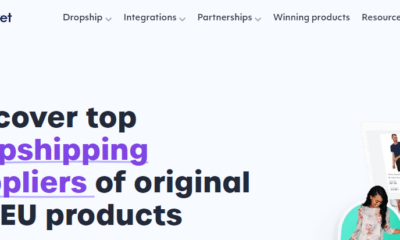MARKETING
Choosing a Cloud Telephony Service for Business: The Dos and Don’ts

The internet is constantly buzzing with what the cloud can accomplish and its evolution.
The enormous popularity is due to its excellent advantages, such as flexibility, scalability, reliability, and affordability, which have been important factors in business adoption of the cloud.
Cloud-based business phone system is an important component of cloud strategy. Cloud telephony helps streamline and optimize critical business processes. Employees are now significantly less likely to be in the workplace, especially since 2020.
Today’s professionals will spend time working from home, clients’ offices, or cafes, as well as on the go. So it’s a high time for replacing the plain old telephony system and move to the cloud.
But what are things you need to consider while choosing a cloud telephony service for business? To find that out, stick till the very end!
What is Cloud telephony?
Cloud telephony is a virtually hosted technology that transforms a traditional phone system into a cloud-based phone system.
Every call that your company receives is routed through Cloud Servers. All vital data, such as customer databases, can be stored in the cloud and accessed at any time using a mobile device or a web browser.
Cloud telephony is a telephony system, which builds, operates, and maintains standardized phone platform solutions on its servers. In this type of phone system, the clients get remote access through the internet.
You can make consumer calls using a web browser or a mobile app using a cloud-based phone system. It allows you to easily handle inbound and outgoing calls with your customers.
Whether you decide to go cloud or not, you’ll need to do a lot of studies. You’ll be able to make smarter decisions equipped with this knowledge of what you can do and what you should avoid.
Things to do while choosing cloud telephony services
How will you choose the right service provider for your business with so many alternatives?
When choosing a cloud computing company, there are a few things to consider.
Here are a few crucial things to address before selecting a cloud service provider.
1. Gather more information
Even if you’ve moved to the cloud and the vendor handles everything, it’ll help your organization if you’re informed of technology trends.
This will assist you in making well-informed judgments and developing superior plans to propel your company forward. Attend cloud computing conferences, seminars, and workshops as much as possible.
2. Double Check on its Quality and Reliability
You’ll begin by deciding on a platform and then looking for providers who can offer it. Since call quality is so important in telephony, you need to look for companies that can deliver a premium voice network.
In order check its reliability and quality, you can request a free trial. You can also look at the reviews dropped by the customers on the various review sites. If you get a satisfactory result while cross-checking its quality and reliability, you can make a decision accordingly.
3. Ensure the system is safe and secure
Security is always the matter of utmost concern in a cloud telephony service. So when choosing a cloud service provider, you must examine several security risks to your data, customer and employee identities, apps, and devices.
The sensitivity of your data will influence your risk tolerance level, but any provider you select should at the very least provide encryption, firewalls, antivirus detection, and user authentication.
Things to Know:
- i. Antivirus detection: What methods are used to detect dangers (e.g., behavioral-based scanning)? Is it updated regularly? Is there a high number of false positives?
- ii. Encryption: Is data automatically encrypted before leaving the cloud services facility at the physical layer?
4. Customer Support
Support is also crucial to remember once the service is up and running. Is the service provider available 24 hours?
Do they promise a specific response time? If you’re a multinational corporation, do you want a provider with global operations that can provide local support?
It’s also crucial to consider the ease and availability of reporting issues, so inquire about phone, email, and live chat support options. You might also inquire about your provider’s typical response and resolution times.
5. Pricing Structure
Because you only pay for the resources you use, cloud computing is a great way to save money. However, before deciding on cloud migration, have a look at how much money you’re currently spending on your current working plan.
Also, because cloud computing pricing varies a lot, be sure you know how and for what you’ll be charged.
Inquire about setup fees and the possibility to add services as needed. Will you bill hourly, monthly, semi-annually, or annually for your services?
6. Check out the feedback from customers:
Companies make claims about customer satisfaction and usability every day, but these statements aren’t wholly true.
Should constantly check customer feedback against company claims. You’ll be able to obtain a quick product summary, complete with a list of features and consumer comments, thanks to customer reviews.
Things to avoid while choosing cloud telephony services
1. Don’t be too picky
There’s nothing wrong with utilizing both the private and public cloud simultaneously. However, conduct a thorough examination of the cloud security concerns that are commonplace.
That isn’t to say you have to be overly picky. While security is crucial while transferring programs, don’t forget to create numerous backups to ensure you don’t lose any data. When it comes to cloud storage and hosting, though, you must be picky.
2. Don’t move too many apps to the cloud
Hundreds of programs, data, and documents may need to be migrated to the cloud in some cases. While it may be tempting to relocate them all at once, this is not a good idea.
Certain applications require significant adjustments, and making all of them before migrating would be prohibitively expensive.
3. Transferring everything to the cloud isn’t a good idea
It’s great to have a new functioning database, but it doesn’t mean you have to shift all of your information to cloud storage.
You may need to save certain files for various reasons, including security and efficiency. Your chief technology specialist can advise you on what to migrate and what not to migrate.
Benefits of Cloud Telephony
Cloud telephony is a good solution for almost any organization. A cloud-based phone system provides various benefits for enterprises, which is why so many of them are quickly adopting it.
So, let’s look more closely at cloud telephony’s advantages.
1. Cost-Efficiency
Not only can cloud telephony save you time, but it also saves you money. The conventional landline phone system, unlike its modern version, requires costly gear, installation, and upkeep.
There’s nothing like long-term fixed deals with a cloud-based telephony solution. It’s all about flexible payment arrangements.
2. High Scalability
When you engage in a Cloud Telephony phone company system, you will no longer have to pay extra today for the possibility of needing more later. The system enables you to purchase a scalable solution deployed across several platforms and environments.
Cloud systems are built to scale to meet the organization’s future demands as they arise. You can edit users, add auto attendants to the system, and create ring groups and campaigns when your business requires it.
3. Reliability and Resilience
Traditional telephone systems can be severely damaged by natural calamities such as cyclones, floods, and earthquakes, while cloud systems are unaffected.
Cloud storage, in reality, keeps information safe and accessible from anywhere. Whatever occurs, you can rest assured that your business will continue to operate.
4. Updating constantly
When you host your business phone system on the cloud, you eliminate the risk of it becoming obsolete over time.
The advancements occurring in the technology domain specific to your organization are updated in your specific communication system through a good hosted solution.
This independence from manually updating your business phone system all of the time allows you to focus on other business processes without being distracted.
5. Extra features are available.
Interactive Voice Response (IVR), call recording, call monitoring, voicemail, real-time analytics, call scheduling, and many other features are available in the cloud.
Final Thought
Hopefully, this article will have clarified the things to consider while choosing cloud telephony for business.
Now that you’ve learned about cloud telephony and what it can do for your company, there’s only one thing left for you to do: Your company’s phone system will be moved to the cloud.
MARKETING
Tinuiti Marketing Analytics Recognized by Forrester

Rapid Media Mix Modeling and Proprietary Tech Transform Brand Performance
Tinuiti, the largest independent full-funnel performance marketing agency, has been included in a recent Forrester Research report titled, “The Marketing Analytics Landscape, Q2 2024.” This report comprehensively overviews marketing analytics markets, use cases, and capabilities. B2C marketing leaders can use this research by Principal Analyst Tina Moffett to understand the intersection of marketing analytics capabilities and use cases to determine the vendor or service provider best positioned for their analytics and insights needs. Moffett describes the top marketing analytics markets as advertising agencies, marketing dashboards and business intelligence tools, marketing measurement and optimization platforms and service providers, and media analytics tools.
As an advertising agency, we believe Tinuiti is uniquely positioned to manage advertising campaigns for brands including buying, targeting, and measurement. Our proprietary measurement technology, Bliss Point by Tinuiti, allows us to measure the optimal level of investment to maximize impact and efficiency. According to the Forrester report, “only 30% of B2C marketing decision-makers say their organization uses marketing or media mix modeling (MMM),” so having a partner that knows, embraces, and utilizes MMM is important. As Tina astutely explains, data-driven agencies have amplified their marketing analytics competencies with data science expertise; and proprietary tools; and tailored their marketing analytics techniques based on industry, business, and data challenges.
Our Rapid Media Mix Modeling sets a new standard in the market with its exceptional speed, precision, and transparency. Our patented tech includes Rapid Media Mix Modeling, Always-on Incrementality, Brand Equity, Creative Insights, and Forecasting – it will get you to your Marketing Bliss Point in each channel, across your entire media mix, and your overall brand performance.
As a marketing leader you may ask yourself:
- How much of our marketing budget should we allocate to driving store traffic versus e-commerce traffic?
- How should we allocate our budget by channel to generate the most traffic and revenue possible?
- How many customers did we acquire in a specific region with our media spend?
- What is the impact of seasonality on our media mix?
- How should we adjust our budget accordingly?
- What is the optimal marketing channel mix to maximize brand awareness?
These are just a few of the questions that Bliss Point by Tinuiti can help you answer.
Learn more about our customer-obsessed, product-enabled, and fully integrated approach and how we’ve helped fuel full-funnel outcomes for the world’s most digital-forward brands like Poppi & Toms.
The Landscape report is available online to Forrester customers or for purchase here.
MARKETING
Ecommerce evolution: Blurring the lines between B2B and B2C

Understanding convergence
B2B and B2C ecommerce are two distinct models of online selling. B2B ecommerce is between businesses, such as wholesalers, distributors, and manufacturers. B2C ecommerce refers to transactions between businesses like retailers and consumer brands, directly to individual shoppers.
However, in recent years, the boundaries between these two models have started to fade. This is known as the convergence between B2B and B2C ecommerce and how they are becoming more similar and integrated.
Source: White Paper: The evolution of the B2B Consumer Buyer (ClientPoint, Jan 2024)
What’s driving this change?
Ever increasing customer expectations
Customers today expect the same level of convenience, speed, and personalization in their B2B transactions as they do in their B2C interactions. B2B buyers are increasingly influenced by their B2C experiences. They want research, compare, and purchase products online, seamlessly transitioning between devices and channels. They also prefer to research and purchase online, using multiple devices and channels.
Forrester, 68% of buyers prefer to research on their own, online . Customers today expect the same level of convenience, speed, and personalization in their B2B transactions as they do in their B2C interactions. B2B buyers are increasingly influenced by their B2C experiences. They want research, compare, and purchase products online, seamlessly transitioning between devices and channels. They also prefer to research and purchase online, using multiple devices and channels
Technology and omnichannel strategies
Technology enables B2B and B2C ecommerce platforms to offer more features and functionalities, such as mobile optimization, chatbots, AI, and augmented reality. Omnichannel strategies allow B2B and B2C ecommerce businesses to provide a seamless and consistent customer experience across different touchpoints, such as websites, social media, email, and physical stores.
However, with every great leap forward comes its own set of challenges. The convergence of B2B and B2C markets means increased competition. Businesses now not only have to compete with their traditional rivals, but also with new entrants and disruptors from different sectors. For example, Amazon Business, a B2B ecommerce platform, has become a major threat to many B2B ecommerce businesses, as it offers a wide range of products, low prices, and fast delivery
“Amazon Business has proven that B2B ecommerce can leverage popular B2C-like functionality” argues Joe Albrecht, CEO / Managing Partner, Xngage. . With features like Subscribe-and-Save (auto-replenishment), one-click buying, and curated assortments by job role or work location, they make it easy for B2B buyers to go to their website and never leave. Plus, with exceptional customer service and promotional incentives like Amazon Business Prime Days, they have created a reinforcing loyalty loop.
And yet, according to Barron’s, Amazon Business is only expected to capture 1.5% of the $5.7 Trillion addressable business market by 2025. If other B2B companies can truly become digital-first organizations, they can compete and win in this fragmented space, too.”
If other B2B companies can truly become digital-first organizations, they can also compete and win in this fragmented space
Joe AlbrechtCEO/Managing Partner, XNGAGE
Increasing complexity
Another challenge is the increased complexity and cost of managing a converging ecommerce business. Businesses have to deal with different customer segments, requirements, and expectations, which may require different strategies, processes, and systems. For instance, B2B ecommerce businesses may have to handle more complex transactions, such as bulk orders, contract negotiations, and invoicing, while B2C ecommerce businesses may have to handle more customer service, returns, and loyalty programs. Moreover, B2B and B2C ecommerce businesses must invest in technology and infrastructure to support their convergence efforts, which may increase their operational and maintenance costs.
How to win
Here are a few ways companies can get ahead of the game:
Adopt B2C-like features in B2B platforms
User-friendly design, easy navigation, product reviews, personalization, recommendations, and ratings can help B2B ecommerce businesses to attract and retain more customers, as well as to increase their conversion and retention rates.
According to McKinsey, ecommerce businesses that offer B2C-like features like personalization can increase their revenues by 15% and reduce their costs by 20%. You can do this through personalization of your website with tools like Product Recommendations that help suggest related products to increase sales.
Focus on personalization and customer experience
B2B and B2C ecommerce businesses need to understand their customers’ needs, preferences, and behaviors, and tailor their offerings and interactions accordingly. Personalization and customer experience can help B2B and B2C ecommerce businesses to increase customer satisfaction, loyalty, and advocacy, as well as to improve their brand reputation and competitive advantage. According to a Salesforce report, 88% of customers say that the experience a company provides is as important as its products or services.
Market based on customer insights
Data and analytics can help B2B and B2C ecommerce businesses to gain insights into their customers, markets, competitors, and performance, and to optimize their strategies and operations accordingly. Data and analytics can also help B2B and B2C ecommerce businesses to identify new opportunities, trends, and innovations, and to anticipate and respond to customer needs and expectations. According to McKinsey, data-driven organizations are 23 times more likely to acquire customers, six times more likely to retain customers, and 19 times more likely to be profitable.
What’s next?
The convergence of B2B and B2C ecommerce is not a temporary phenomenon, but a long-term trend that will continue to shape the future of ecommerce. According to Statista, the global B2B ecommerce market is expected to reach $20.9 trillion by 2027, surpassing the B2C ecommerce market, which is expected to reach $10.5 trillion by 2027. Moreover, the report predicts that the convergence of B2B and B2C ecommerce will create new business models, such as B2B2C, B2A (business to anyone), and C2B (consumer to business).
Therefore, B2B and B2C ecommerce businesses need to prepare for the converging ecommerce landscape and take advantage of the opportunities and challenges it presents. Here are some recommendations for B2B and B2C ecommerce businesses to navigate the converging landscape:
- Conduct a thorough analysis of your customers, competitors, and market, and identify the gaps and opportunities for convergence.
- Develop a clear vision and strategy for convergence, and align your goals, objectives, and metrics with it.
- Invest in technology and infrastructure that can support your convergence efforts, such as cloud, mobile, AI, and omnichannel platforms.
- Implement B2C-like features in your B2B platforms, and vice versa, to enhance your customer experience and satisfaction.
- Personalize your offerings and interactions with your customers, and provide them with relevant and valuable content and solutions.
- Leverage data and analytics to optimize your performance and decision making, and to innovate and differentiate your business.
- Collaborate and partner with other B2B and B2C ecommerce businesses, as well as with other stakeholders, such as suppliers, distributors, and customers, to create value and synergy.
- Monitor and evaluate your convergence efforts, and adapt and improve them as needed.
By following these recommendations, B2B and B2C ecommerce businesses can bridge the gap between their models and create a more integrated and seamless ecommerce experience for their customers and themselves.
MARKETING
Streamlining Processes for Increased Efficiency and Results

How can businesses succeed nowadays when technology rules? With competition getting tougher and customers changing their preferences often, it’s a challenge. But using marketing automation can help make things easier and get better results. And in the future, it’s going to be even more important for all kinds of businesses.
So, let’s discuss how businesses can leverage marketing automation to stay ahead and thrive.
Benefits of automation marketing automation to boost your efforts
First, let’s explore the benefits of marketing automation to supercharge your efforts:
Marketing automation simplifies repetitive tasks, saving time and effort.
With automated workflows, processes become more efficient, leading to better productivity. For instance, automation not only streamlines tasks like email campaigns but also optimizes website speed, ensuring a seamless user experience. A faster website not only enhances customer satisfaction but also positively impacts search engine rankings, driving more organic traffic and ultimately boosting conversions.
Automation allows for precise targeting, reaching the right audience with personalized messages.
With automated workflows, processes become more efficient, leading to better productivity. A great example of automated workflow is Pipedrive & WhatsApp Integration in which an automated welcome message pops up on their WhatsApp
within seconds once a potential customer expresses interest in your business.
Increases ROI
By optimizing campaigns and reducing manual labor, automation can significantly improve return on investment.
Leveraging automation enables businesses to scale their marketing efforts effectively, driving growth and success. Additionally, incorporating lead scoring into automated marketing processes can streamline the identification of high-potential prospects, further optimizing resource allocation and maximizing conversion rates.
Harnessing the power of marketing automation can revolutionize your marketing strategy, leading to increased efficiency, higher returns, and sustainable growth in today’s competitive market. So, why wait? Start automating your marketing efforts today and propel your business to new heights, moreover if you have just learned ways on how to create an online business
How marketing automation can simplify operations and increase efficiency
Understanding the Change
Marketing automation has evolved significantly over time, from basic email marketing campaigns to sophisticated platforms that can manage entire marketing strategies. This progress has been fueled by advances in technology, particularly artificial intelligence (AI) and machine learning, making automation smarter and more adaptable.
One of the main reasons for this shift is the vast amount of data available to marketers today. From understanding customer demographics to analyzing behavior, the sheer volume of data is staggering. Marketing automation platforms use this data to create highly personalized and targeted campaigns, allowing businesses to connect with their audience on a deeper level.
The Emergence of AI-Powered Automation
In the future, AI-powered automation will play an even bigger role in marketing strategies. AI algorithms can analyze huge amounts of data in real-time, helping marketers identify trends, predict consumer behavior, and optimize campaigns as they go. This agility and responsiveness are crucial in today’s fast-moving digital world, where opportunities come and go in the blink of an eye. For example, we’re witnessing the rise of AI-based tools from AI website builders, to AI logo generators and even more, showing that we’re competing with time and efficiency.
Combining AI-powered automation with WordPress management services streamlines marketing efforts, enabling quick adaptation to changing trends and efficient management of online presence.
Moreover, AI can take care of routine tasks like content creation, scheduling, and testing, giving marketers more time to focus on strategic activities. By automating these repetitive tasks, businesses can work more efficiently, leading to better outcomes. AI can create social media ads tailored to specific demographics and preferences, ensuring that the content resonates with the target audience. With the help of an AI ad maker tool, businesses can efficiently produce high-quality advertisements that drive engagement and conversions across various social media platforms.
Personalization on a Large Scale
Personalization has always been important in marketing, and automation is making it possible on a larger scale. By using AI and machine learning, marketers can create tailored experiences for each customer based on their preferences, behaviors, and past interactions with the brand.
This level of personalization not only boosts customer satisfaction but also increases engagement and loyalty. When consumers feel understood and valued, they are more likely to become loyal customers and brand advocates. As automation technology continues to evolve, we can expect personalization to become even more advanced, enabling businesses to forge deeper connections with their audience. As your company has tiny homes for sale California, personalized experiences will ensure each customer finds their perfect fit, fostering lasting connections.
Integration Across Channels
Another trend shaping the future of marketing automation is the integration of multiple channels into a cohesive strategy. Today’s consumers interact with brands across various touchpoints, from social media and email to websites and mobile apps. Marketing automation platforms that can seamlessly integrate these channels and deliver consistent messaging will have a competitive edge. When creating a comparison website it’s important to ensure that the platform effectively aggregates data from diverse sources and presents it in a user-friendly manner, empowering consumers to make informed decisions.
Omni-channel integration not only betters the customer experience but also provides marketers with a comprehensive view of the customer journey. By tracking interactions across channels, businesses can gain valuable insights into how consumers engage with their brand, allowing them to refine their marketing strategies for maximum impact. Lastly, integrating SEO services into omni-channel strategies boosts visibility and helps businesses better understand and engage with their customers across different platforms.
The Human Element
While automation offers many benefits, it’s crucial not to overlook the human aspect of marketing. Despite advances in AI and machine learning, there are still elements of marketing that require human creativity, empathy, and strategic thinking.
Successful marketing automation strikes a balance between technology and human expertise. By using automation to handle routine tasks and data analysis, marketers can focus on what they do best – storytelling, building relationships, and driving innovation.
Conclusion
The future of marketing automation looks promising, offering improved efficiency and results for businesses of all sizes.
As AI continues to advance and consumer expectations change, automation will play an increasingly vital role in keeping businesses competitive.
By embracing automation technologies, marketers can simplify processes, deliver more personalized experiences, and ultimately, achieve their business goals more effectively than ever before.
-

 SEO7 days ago
SEO7 days agoGoogle Limits News Links In California Over Proposed ‘Link Tax’ Law
-

 SEARCHENGINES6 days ago
SEARCHENGINES6 days agoGoogle Core Update Volatility, Helpful Content Update Gone, Dangerous Google Search Results & Google Ads Confusion
-
SEARCHENGINES7 days ago
Daily Search Forum Recap: April 12, 2024
-

 SEO6 days ago
SEO6 days ago10 Paid Search & PPC Planning Best Practices
-

 MARKETING6 days ago
MARKETING6 days ago2 Ways to Take Back the Power in Your Business: Part 2
-

 MARKETING5 days ago
MARKETING5 days ago5 Psychological Tactics to Write Better Emails
-

 SEARCHENGINES5 days ago
SEARCHENGINES5 days agoWeekend Google Core Ranking Volatility
-

 PPC6 days ago
PPC6 days agoCritical Display Error in Brand Safety Metrics On Twitter/X Corrected













You must be logged in to post a comment Login